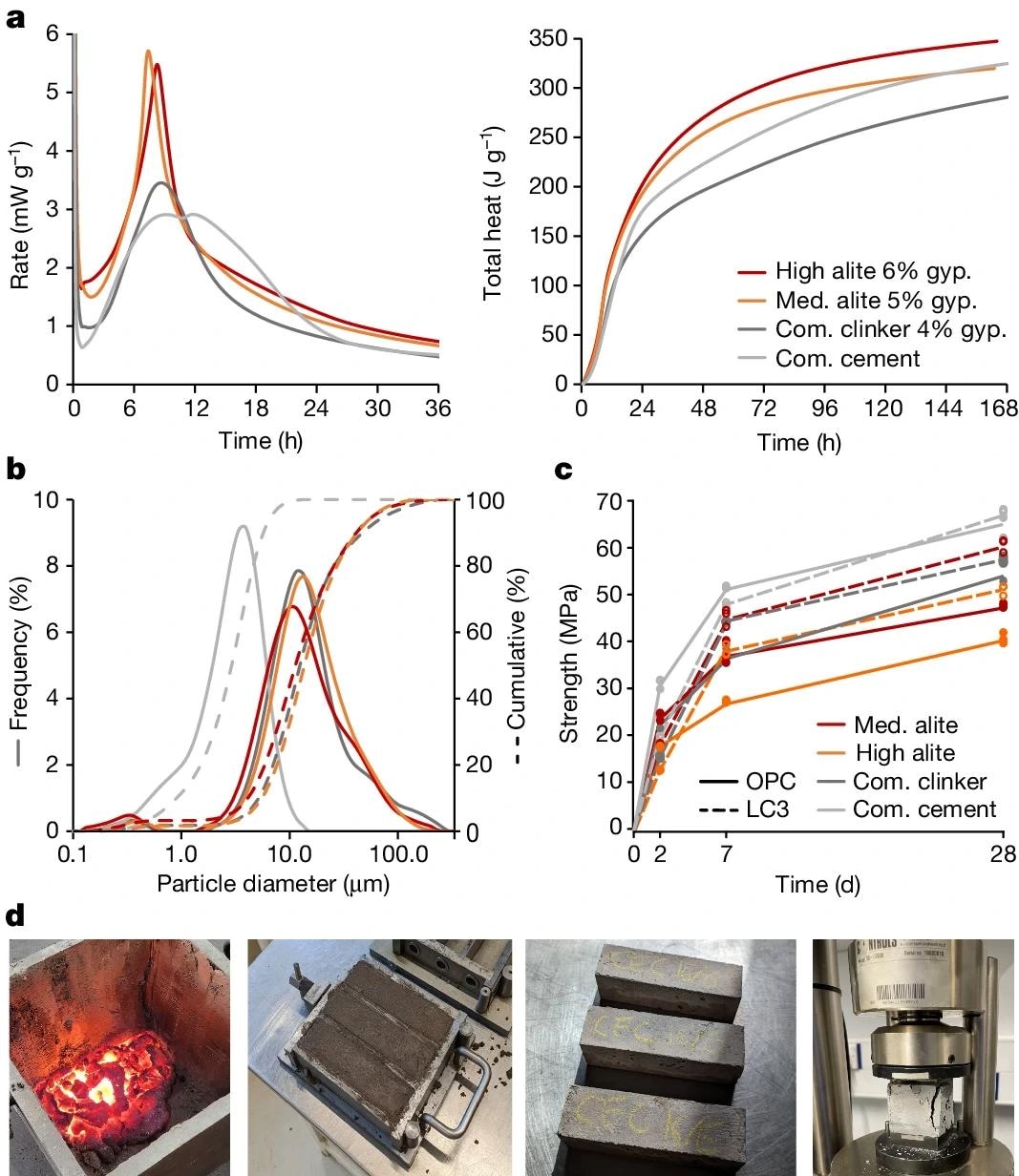In a recent article published in the journal Nature, researchers discuss a novel approach to electric recycling of Portland cement, aiming to reduce CO2 emissions in cement production. By incorporating recovered cement paste as a substitute for the lime-dolomite flux traditionally used in steel recycling, the study aims to create a closed-loop system that produces zero-emissions cement. This innovative process has the potential to significantly impact the sustainability of the cement industry.
 a, Instantaneous and cumulative heat released by high- and medium-alite cement and high-C3A cement produced with the new process, commercial clinker ground in the same conditions and commercial cement produced with the commercial clinker shown for reference. b, Cumulative and frequency plots of the particle size distributions of the cements used for the strength tests. c, Strength evolution of cements produced using the new process, both as pure cements and LC3 blends. d, Slag as poured from the furnace, fresh and hardened mortar bars; sample after compression failure. Med., medium; Com., commercial; gyp., gypsum. Image Credit: https://www.nature.com/articles/s41586-024-07338-8
a, Instantaneous and cumulative heat released by high- and medium-alite cement and high-C3A cement produced with the new process, commercial clinker ground in the same conditions and commercial cement produced with the commercial clinker shown for reference. b, Cumulative and frequency plots of the particle size distributions of the cements used for the strength tests. c, Strength evolution of cements produced using the new process, both as pure cements and LC3 blends. d, Slag as poured from the furnace, fresh and hardened mortar bars; sample after compression failure. Med., medium; Com., commercial; gyp., gypsum. Image Credit: https://www.nature.com/articles/s41586-024-07338-8
Background
The cement industry plays a crucial role in global CO2 emissions, contributing approximately 7.5 % of total anthropogenic emissions. These emissions primarily stem from processes like limestone decarbonization and fossil fuel combustion, highlighting the pressing need for sustainable practices in cement manufacturing to mitigate environmental impact.
Current strategies to reduce emissions in cement production involve substituting Portland clinker with supplementary materials, exploring alternative binders, and implementing carbon capture and storage technologies. However, these approaches have limitations, including emissions associated with the production of supplementary materials and challenges in achieving complete emission reduction with existing technologies.
In response to these challenges, there is growing interest in exploring innovative solutions that leverage existing resources to reduce emissions in cement production. One such approach involves the utilization of used cement as a decarbonized feedstock, presenting an opportunity to minimize the environmental footprint of cement manufacturing processes.
The Current Study
To evaluate the feasibility of electric recycling of Portland cement, a series of experiments were conducted using recovered cement paste and steel recycling processes. A total of 28 slags were produced from flux derived from cement paste, which included lime, alumina, and silica additives. The fluxes were prepared specifically for this study and recovered from demolition waste to assess the viability of using recycled materials.
The slags were processed in induction furnaces over clean steel, utilizing various crucibles and oxidizing conditions to optimize the production process. Following the induction furnace treatment, the slags were air-cooled at rapid rates to stabilize the alite phase and enhance the quality of the resulting material. Subsequently, the cooled slags were crushed and ground to remove any steel residuals and ensure a homogeneous composition.
Chemical composition analyses of the slags were performed using X-Ray fluorescence (XRF) to determine the elemental content. Additionally, X-Ray diffraction (XRD) analyses were conducted to identify the crystalline phases present in the slags. Rietveld refinement was employed to quantitatively analyze the phases and assess the mineralogical composition of the slags.
In parallel, cement pastes and mortars were prepared to demonstrate the effectiveness of the process and characterize the properties of the resulting materials. Blending cements were utilized to create mortar bars for testing, allowing for a comprehensive evaluation of the performance and quality of the recycled cement products.
Results and Discussion
The experimental results revealed promising outcomes regarding the feasibility and effectiveness of electric recycling of Portland cement using recovered cement paste within the steel recycling process. Analysis of the produced slags indicated a composition closely resembling that of conventional Portland cement, with predominant phases of alite and belite, essential components for high-quality clinker production.
Furthermore, the XRF analyses confirmed the appropriate elemental composition of the slags, demonstrating the successful incorporation of recovered cement paste into the steel recycling process. The XRD analyses revealed the presence of cementitious phases typical of Portland cement, such as alite (C3S), belite (C2S), C4AF, and tricalcium aluminate (C3A), validating the potential of the recycled materials for cement production.
The characterization of the slags indicated good cement setting times and strength development, comparable to commercial clinker, despite being under-sulfated and containing contaminants. The relationship between strength development and heat release for the new clinker was like that of conventional commercial clinker, highlighting the potential for high-quality cement production through the electric recycling process.
Conclusion
In conclusion, the successful implementation of electric recycling of Portland cement at scale highlights the importance of exploring novel solutions to address the environmental challenges associated with cement production. By leveraging existing industrial-scale equipment and materials, this approach presents a viable pathway toward reducing the carbon footprint of the cement industry while promoting a more sustainable and environmentally conscious approach to construction materials.
Overall, the study underscores the significance of innovation and collaboration in driving sustainable practices in cement manufacturing. By harnessing the potential of recovered materials and embracing circular economy principles, the industry can move towards a more environmentally friendly and resource-efficient future, contributing to global efforts to combat climate change and reduce carbon emissions.
Article Revisions
- May 31 2024 - Title changed from "Zero-Emissions Cement through Electric Recycling" to "Innovative Cement Solutions: Achieving Zero Emissions with Electric Recycling"